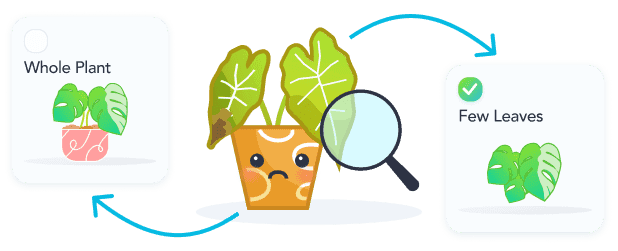
Care Guides for Raven ZZ Plant
Every 7d
Recommended Frequency
1 /2 cup of water
Recommended Amount
ZZ plants have thick waxy leaves which retain some water, so it's best to err on the side of less water. Check soil once a week and water until it runs through the bottom when the top inch is dry.
Every 30d
Recommended Frequency
Fertilize your Raven ZZ plant once a month during spring and summer using a liquid fertilizer diluted by half.
Indirect Sun
Recommended
Indirect Sun or Filtered Sun is when sun exposure is being filtered through a sheer curtain or is not able to have the sun's rays directly hit the leaves/flowers of your plant.
Every 730d
Recommended Frequency
Repot your Raven ZZ Plant every two years, or once it outgrows its pot.
Loamy Soil
Recommended Soil
Peat Soil is an acidic soil that retains a lot of moisture and slows decomposition. Due to such a high moisture retention this mix may require irrigation to help with draining. This soil type is best used when paired wit...

Shop Raven ZZ Plant
Questions about Raven ZZ Plant
The Raven ZZ plant, scientifically known as Zamioculcas zamiifolia 'Raven', is a striking houseplant characterized by its dark, glossy leaves that emerge from thick, upright stems. This unique plant is a cultivar of the ...

Toxicity of Raven ZZ Plant

Common Pests and Diseases
Root Rot
Overwatering is the primary cause of root rot in raven zz plants. When the soil remains consistently soggy, it deprives the roots of oxygen and creates a favorable environment for fungal pathogens. This leads to the decay of the roots, which can ultimately kill the plant if not addressed promptly.
To remedy root rot, first, stop watering the plant immediately and allow the soil to dry out completely. Carefully remove the plant from its pot and inspect the roots. Trim away any blackened or mushy roots with sterilized scissors. Repot the plant in fresh, well-draining soil and a pot with drainage holes. Ensure that you only water the plant when the top inch of soil feels dry to the touch, and consider using a moisture meter to prevent future overwatering.
Leaf Dropping
Underwatering can lead to insufficient moisture in the soil, causing the raven zz plant to experience stress. This stress manifests as leaf dropping, where the plant sheds its leaves to conserve water and energy.
To remedy leaf dropping due to underwatering, first assess the soil moisture by sticking your finger about an inch into the soil. If it feels dry, it's time to water. Water the plant thoroughly until excess moisture drains from the bottom of the pot. Ensure that the pot has drainage holes to prevent waterlogging. Going forward, establish a regular watering schedule, allowing the top inch of soil to dry out between waterings. Adjust the frequency based on environmental conditions, such as humidity and temperature.
Mealybugs
Mealybugs are small, white, cottony insects that feed on the sap of the raven ZZ plant, weakening it and causing yellowing leaves and stunted growth.
To manage mealybugs, start by isolating the affected plant to prevent spreading. Use a cotton swab dipped in rubbing alcohol to remove them manually from the leaves and stems. For larger infestations, consider applying insecticidal soap or neem oil, following the manufacturer's instructions. Regularly inspect your plant and maintain good air circulation to deter future infestations. Additionally, keep the plant healthy with proper watering and light conditions, as a strong plant is less susceptible to pests.
Leaf Yellowing
Leaf yellowing in raven ZZ plants can occur due to nutrient deficiencies, particularly nitrogen or magnesium. These deficiencies can arise from poor soil quality or lack of fertilization, leading to inadequate nutrient uptake by the plant.
To address leaf yellowing, start by assessing the soil quality and consider repotting the plant in a well-draining potting mix that is rich in organic matter. Additionally, apply a balanced, water-soluble fertilizer every 4-6 weeks during the growing season to replenish nutrients. If the yellowing persists, a magnesium supplement can be beneficial. Always follow the recommended dosage to avoid over-fertilization, which can lead to further issues.

Related Plants
Other Articles:
Top 10 Most Popular Roses
Mar 22, 2022
How to Care for China Roses
Mar 11, 2022
How to Care for Chinese Money Plants
May 15, 2020
How to Grow and Care for A Bird of Paradise
Apr 26, 2020
Top 10 Plants To Grow In A Terrarium
May 31, 2022
How to Grow and Care for Lucky Bamboo
Mar 29, 2022
How to Grow and Care for Corn Plants
Mar 29, 2022
How to Care for Madagascar Dragon Trees
Mar 21, 2022


